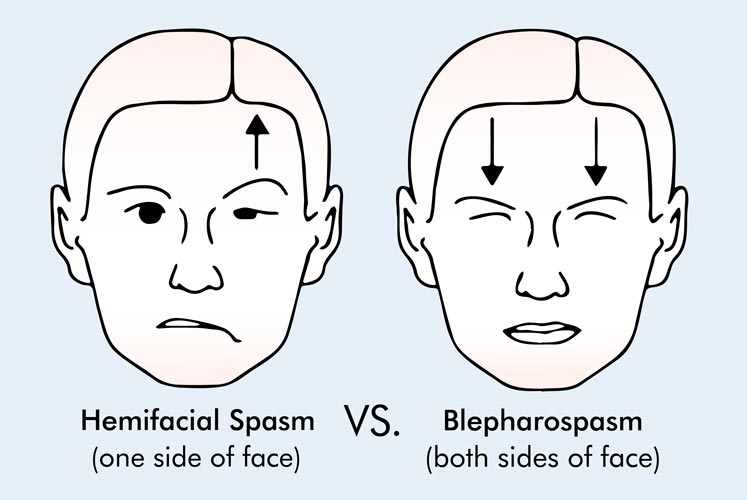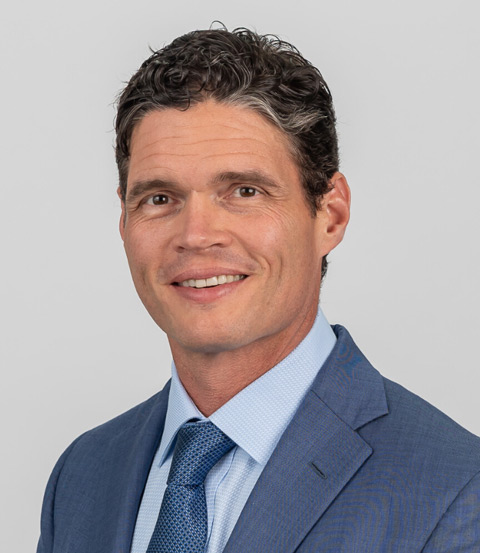
What is hemifacial spasm?
Hemifacial spasm is a rare movement disorder that causes involuntary facial muscle spasms. Most often, these spasms result from nerve compression by a displaced artery or vein. When the artery pushes on the nerve, it can cause a disruption in the nerve’s signals. This disruption can cause the characteristic facial spasm.
Hemifacial spasm (twitches or contractions affecting one side of the face) should not be confused with blepharospasm (twitches or contractions affecting both sides of the face).
Would you like to request a hemifacial spasm consultation?
What causes hemifacial spasm?
Hemifacial spasm can result from several different conditions and factors. The exact cause of hemifacial spasm can only be determined by a trained physician. However, some of the most common causes include:
- Injury or tumor. Some patients are diagnosed with hemifacial spasm after injury to the facial nerve or diagnosis of a tumor pressing on the facial nerve.
- Bell’s Palsy. Bell’s Palsy is most often caused by an infection of the facial nerve that causes weakness and “droopiness” in one side of the face. While not all patients with Bell’s Palsy develop hemifacial spasm, some may develop facial spasms after diagnosis.
- Nerve compression. Usually, hemifacial spasm is the result of compression on the facial nerve—the seventh cranial nerve (CN VII). This nerve controls the facial muscles and movement of the mouth, lips, eyelids and eyebrows.
Patients with hemifacial spasm most commonly exhibit signs of nerve compression. The anterior inferior cerebellar artery is an artery that begins in the brain stem and supplies blood to the brain. However, the artery can sometimes be displaced and apply pressure on the facial nerve. This compression causes the facial nerve to misfire. When the nerve doesn’t send signals properly, the facial muscles may contract or spasm.
Hemifacial spasm symptoms
Hemifacial spasm is not life-threatening, but it causes symptoms that can interfere with everyday life. Though the spasms are usually not painful, they may cause difficulty speaking, eating, driving (due to vision impairment) and more. Most often, patients first experience twitches around the eye that progress down the face until they experience full facial spasms, though a small number of patients may experience spasms in the lower face first. Spasms or twitching may even continue during sleep, causing sleep disruptions. The most common symptoms include:
- Eyelid twitches
- Mouth twitches
- Facial twitching
- Changes in hearing
- Clicking sound in the ear
Hemifacial spasm is usually a unilateral occurrence, meaning it most often affects only one side - or hemisphere - of the face; however, in rare instances some patients may experience spasms on both sides. Hemifacial spasm may cause clonic or tonic spasms. Clonic spasms refer to an almost rhythmic movement, usually called a twitch. In contrast, tonic spasms occur when the facial muscles go rigid - almost as if they are “stuck.”
For more patients, hemifacial spasm symptoms are progressive, with spasms becoming worse over time. For example, eyelid twitches may become more frequent and last longer, causing the eye to close and water for periods of time. This can severely impact the ability to drive or perform daily tasks, such as reaching. In addition, full facial spasms may become more pronounced and may occur more frequently during times of stress.
Psychological symptoms
In addition to the physical symptoms of hemifacial spasm, patients often experience psychological symptoms. Because facial spasms are involuntary and can occur frequently, patients may withdraw from social circumstances. Embarrassment from frequent face twitches and tics can lead to decreased social and work activity. Additionally, many patients suffer from hemifacial spasm for many years with a misdiagnosis or without suitable treatment options. This can lead to lower quality of life and related symptoms, such as social anxiety.
DO YOU HAVE
HEMIFACIAL SPASM?
Though rare, hemifacial spasm is often misdiagnosed. If you think you may have hemifacial spasm, try out our symptom checker.


DO YOU HAVE
HEMIFACIAL SPASM?
Though rare, hemifacial spasm is often misdiagnosed. If you think you may have hemifacial spasm, try out our symptom checker.

ABOUT DR. ULM
Arthur J. Ulm is a board-certified neurosurgeon who provides expert neurosurgical care for brain, spine and vascular disorders. During his microsurgical anatomy fellowship, he trained under the world-renowned neurosurgeon, Professor Albert L. Rhoton, Jr., MD, the pioneer of microvascular decompression surgery. MVD is the only known permanent treatment for hemifacial spasm. Dr. Ulm is one of the region’s leading neurosurgeons, with advanced training in hemifacial spasm treatment.
Dr. Ulm sees patients at Nashville Neurosurgery Associates. For more information, or to schedule an appointment, please contact us.

ABOUT DR. ULM
Arthur J. Ulm is a board-certified neurosurgeon who provides expert neurosurgical care for brain, spine and vascular disorders. During his microsurgical anatomy fellowship, he trained under the world-renowned neurosurgeon, Professor Albert L. Rhoton, Jr., MD, the pioneer of microvascular decompression surgery. MVD is the only known permanent treatment for hemifacial spasm. Dr. Ulm is one of the region’s leading neurosurgeons, with advanced training in hemifacial spasm treatment.
Dr. Ulm sees patients at Nashville Neurosurgery Associates. For more information, or to schedule an appointment, please contact us.
Want to know more about hemifacial spasm diagnosis and treatment?
CHARLIE JOE
Charlie Joe came to Dr. Ulm after diagnosis and unsuccessful treatment of his hemifacial spasms. After meeting and discussing his options with Dr. Ulm, Charlie Joe and his wife, Jane, decided he should have Microvascular Decompression Surgery, the only known permanent treatment for hemifacial spasm. Since surgery, Charlie Joe has been spasm free.
